Abstract
Urban ecological planning uses ecology, environmental science, economics, and urbanology to adjust and transform various complex urban relationships, seeking to expand benefits and reducing risks. Environmental music, a kind of non appreciative music, can act on subject consciousness and may influence the urban ecosystem in which it is employed. Many connections appear between urban ecological planning and environmental music. This study took the university town of Hefei City, Anhui Province, China, as an example. This work was conducted to explore the effects of environmental music on the development of urban ecological planning by combining relevant studies of environmental science, urban ecology, urban planning, and musicology. The results showed that environmental music, as a cultural information flow, affected the urban ecosystem and had a typical function for different ecological function zones in the city. Different types of environmental music had spiritual and cultural publicity functions in regulating the main body of the urban ecosystem (residents and students), and it also influenced the growth of common plants in cities and had different ecological and environmental effects.
1. Introduction
In recent decades, the urbanization process has been speeding up, resulting in the excessive concentration of the city population, a pluralistic characteristic, and environmental protection problems. Urban ecological planning is an important technique for environmental protection and is closely related to the health and harmonious development of the city. Urban planning or modeling also plays an important role in the “economy–ecology–society” trinity of sustainable development. Urban ecological planning is a new cultural concept that uses ecology, environmental science, economics, and urbanology to adjust and transform various complex urban relationships, seeking to expand benefits and reducing risks. Additionally, urban ecological planning is aimed at the urban ecosystem from the perspective of ecology. The urban ecosystem is a kind of artificial ecosystem formed by the interaction between urban residents and their living environment. Scientific urban ecological planning and design can maintain a virtuous cycle of the urban ecosystem and present a pattern of coordinated development of urban construction, economic construction, and environmental construction [1]. The fundamental purpose of urban ecological planning is to realize the harmony between man and nature and to emphasize regional coordination. The planning features are mainly reflected in the following factors. First, social ecology: urban ecological planning should focus on social development, which includes politics, economy, culture, and other aspects of social life. Second, economic ecology: urban ecological planning and design should implement the mainstream of society, energy conservation, and emission reduction, improve resource utilization rate, and optimize the industrial economic structure. Third, natural ecology: urban ecological planning and design should be combined with the natural ecosystem, reduce the negative impact on the natural environment, and use favorable factors to promote urban development. Fourth, compound ecology: Urban society, economy, and ecology are interrelated as a whole, and urban ecological planning should follow the connection of these three [1,2,3].
Urban acoustic environmental planning is an important part of urban ecological environment planning. How to effectively adapt the urban acoustic environment to urban sustainable development is one of the urban problems that urban residents pay great attention to. In the urban ecosystem, environmental music is one of the important components of acoustic environments and is also one of the important ways for music culture to spread in the city [4]. In a sense, it can regulate human psychological and physical wellbeing, so as to improve people’s labor or work efficiency and finally to promote urban development and social harmony [5,6,7,8]. In actuality, music was considered to have an enlightenment function and could affect people’s psychology as early as Ancient Greece or even earlier [4].
In the 1960s, the concept of environmental music was formally proposed in the field of musicology. Environmental music has a typical function in a broad sense, which refers to the music which is a constituent factor of the human living environment and is closely related to human life. In addition, environmental music has typical ideological characteristics in the narrow sense, which refers to the music specially designed for a specific environment [4]. Environmental music can play a certain role in improving the human living environment and regulating the human psychological environment [9,10,11,12,13,14,15]. It has been deeply involved in a wide range of social environments and has been paid more and more attention by people. Outside China, the research on environmental music is leading in Europe and the United States, with the characteristics of a close combination of production, education, and research [7,8,9,10]. Among them, the most representative achievements include the concepts of “exhibition music”, “atmosphere music”, and “background noise”, proposed by French composer Miller, music sociologists John Cage and Jacques Attali, respectively, and the monograph “Aesthetics of Environmental Music” published by Japanese composer Hattori Tadashi’s “Environmental Music Research Group” [16,17,18,19]. In China, the study of environmental music has the characteristics of individual research with a loose combination of production, university, and research. In the 1990s, a research group organized by Si Youlun of People’s University of China translated and edited the monograph “Aesthetics of Environmental Music” by Hattori Tadashi [19], which marked the beginning of systematic research on environmental music in China [20,21,22].
Currently, there are few studies on the relationship between environmental music and urban ecological planning. Therefore, in this present study, inhabitants and plants in the urban ecosystem were considered the research objects. Taking the university town of Hefei City in Anhui Province, China, as an example, the authors preliminarily discussed the role of environmental music in urban ecological planning and the coupling relationship between both through specific investigation and research. This work aimed to provide some basis for urban ecological planning.
2. Materials and Methods
2.1. Experimental Design
In the beginning of the 1990s, the university towns were developed one after another in large cities in China and had the characteristics of urbanization. However, the types and volumes of environmental music in different ecological function zones of the city are closely related to the functional properties of the area. In order to study the relationship between urban ecological planning and environmental music, the effects of environmental music on the population and plants in Hefei University Town were explored by in-depth investigation and research. Hefei University Town, located in Hefei Economic and Technological Development Zone, China, was founded on 18 November 2001. In the late 20th century, the colleges and universities in Hefei began to move southward in response to the development needs of Hefei City, and, finally, major colleges and universities were built in the area centered on the Feicui Lake. In this study, the selected area in Hefei University Town was located in the southwest of Hefei City, covering an area of about 3.6 km2 with a population of about 100,000 and including a teaching district, a living area, and a scenic and tourist area (Figure 1).
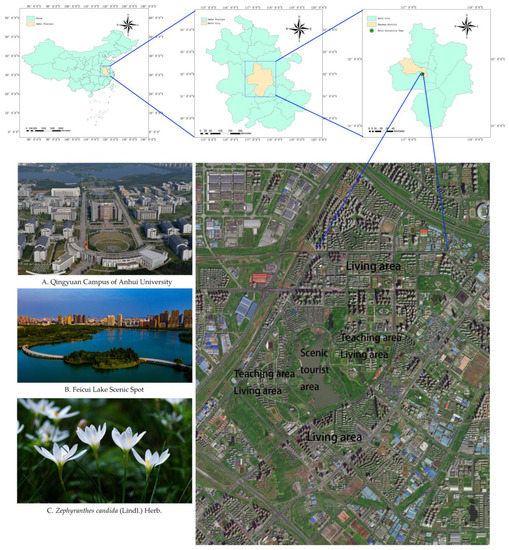
Figure 1.
Hefei University Town (function partition of study area and sampling point distribution): (A) Qingyuan Campus of Anhui University [23]; (B) Feicui Lake Scenic Spot [24]; (C) Zephyranthes candida (Lindl.) Herb. [25].
2.2. Effect of Environmental Music on People in the Urban Ecosystem (Experiment 1)
In the preliminary work, the authors consulted the relevant data of environmental music and selected Qingyuan Campus of Anhui University (Figure 1A [23]) and Feicui Lake Park (Figure 1B [24]) as the research areas. Anhui University is a key construction university in China. Qingyuan Campus of Anhui University is located in the university town on the west side of Hefei Economic and Technological Development Zone, and the floor area is about 133 hm2 and it was used in 2003. The Feicui Lake Scenic Spot was built in 2006 and is located at No. 1 Rongcheng Road, Shushan District, Hefei, Anhui Province. The whole scenic spot covers an area of about 135 hm2, including about 63 hm2 of lake surface, which was reconstructed from the Gugeng Reservoir. The terrain is gentle, with the water surface, various trees, and beautiful natural scenery. The emerald lake scenery is divided into four districts and one park, ecological leisure and entertainment scenic spots, dam landscape interaction area, Jade Lake Welcome Hotel Area, and Feicui Park.
We carried out a small area of preliminary test and a questionnaire survey on environmental music in the above two areas. Considering the influence of outdoor space weather and temperature factors, the test and questionnaire were conducted in March 2022. We selected three classical music, three pop music, and three folk music samples to play on the campus and in the park in a cycle, and in the restaurant for three consecutive days (17:30 p.m. to 20:00 p.m.), and the volume was set at 50 dB(A). There was a buried speaker every fifty meters in the park, the average sound pressure level of the surveyed area was 50 dB(A), and the SPL was measured using the Norsonic Nor121 (Norsonic Co., Ltd., Tranby, Norway) and BSWA801 (Beijing Tongde Entrepreneurship Technology Co., Ltd., Beijing, China) sound level meters and then analyzed using 01 dB software (01dB-Metravib Co., Ltd., Paris, France). During the measurement, the temperature was 20 °C, and the relative humidity of the tested area was about 60%. The measurements were made according to the ISO sound level standards prepared by International Organization for Standardization (ISO 12913-1:2014 Acoustics—Soundscape—Part 1: Definition and Conceptual Framework.) Due to the high mobility of personnel in campus restaurants and parks, in order to ensure the accuracy of the test results, the method of random selection of survey subjects was adopted in the restaurant and scenic spot, and one person was selected every 8 min from 17:30 to 20:00. Conducted by two people simultaneously, two investigators were all graduate students with research experience. Before filling in the questionnaire, it was confirmed that the respondents’ hearing was normal, by asking. This study protocol was approved by the ethics review board of Anhui Provincial Philosophy and Social Science Planning Office. The questionnaire survey was conducted voluntarily by the respondents. We obtained written informed consent from all study participants. The questionnaire was completed within three days. Eventually, a total of 105 copies were sent and 100 copies were recycled.
The questionnaire included respondents’ background information and their perception of environmental music. The purpose of the first part of the questionnaire was to obtain the demographic characteristics of the respondents, such as gender, age (under 18 years old, 18–59 years old, 60 years old and above), and educational background (bachelor’s degree or below, master’s degree, doctoral degree), as shown in Figure 2. The second part of the questionnaire (Table 1) was about the respondents’ preferences for environmental music cognition, and affinity of playback venues and types.
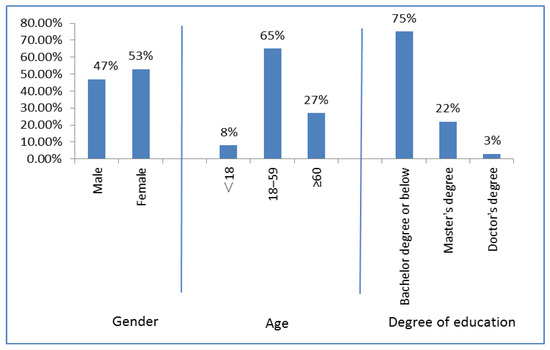
Figure 2.
Basic composition of interviewees in Qingyuan Campus of Anhui University and Feicui Lake Scenic Spot.

Table 1.
Question and answer classification settings for the questionnaire, Qingyuan Campus of Anhui University and Feicui Lake Scenic Spot.
2.3. Effect of Environmental Music on the Urban Plant Growth (Experiment 2)
Zephyranthes candida (Lindl.) Herb. (Figure 1C [25]), a common herb of urban gardens, is widely distributed in South and East China. It is also a common plant in the Feicui Lake area. The study subjects were planted by pot experiments in Hefei University in April 2022. The variety of Zephyranthes candida seeds were purchased from Zhongying Flowers and Trees Garden Co., Ltd., Shuyang County, Suqian City, Jiangsu Province, China. After germination, 20-day-old seedlings were transplanted into nutrient soil in two 40 m greenhouses and isolated. One greenhouse had no music (as the control: CK), and the other greenhouse had ordinary audio equipment to play classical music (CM), which played for 3 h a day (Figure 3). The greenhouse temperature was maintained at 24 ± 4 °C in the growth chamber, and the relative humidity was 65 ± 5%. The audio content was Saxophone Quartet (Mozart’s Quartet No. 21 in D major, K. 575), the audio loudness was about 80 dB(A), the SPL in greenhouses was measured using the Norsonic Nor121 (Norsonic Co., Ltd., Tranby, Norway) and BSWA801 (Beijing Tongde Entrepreneurship Technology Co., Ltd., Beijing, China) sound level meters and then analyzed using 01 dB software (01dB-Metravib Co., Ltd., Paris, France), and the effective range of audio frequency was 30 m from the audio speaker. After 30 days of growth, 10 seedlings were taken from each pot to determine growth index, and the average was calculated. For further research, we used the software GoldWave (GoldWave Inc., St. John’s, NL, Canada) to produce spectrogram and spectrum (Figure 4).
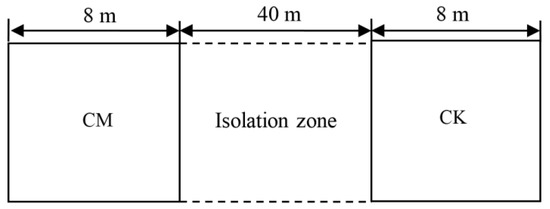
Figure 3.
Schematic diagram of location of experiment.
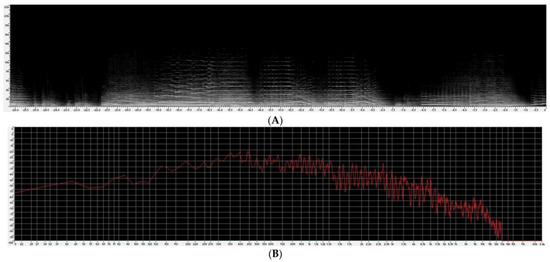
Figure 4.
Acoustic characteristic diagram (CM, Saxophone Quartet: Mozart’s Quartet No. 21 in D major, K. 575). (A) spectrogram (B) spectrum. Note: volume level was 80 dB(A), and red lines represent peaks.
3. Results
3.1. Questionnaire (Experiment 1)
Table 1 indicates the questionnaire survey on environmental music among people in Hefei University Town. The results showed that most respondents had a general understanding of environmental music and thought that life needs environmental music (Figure 5). Most of them believed that environmental music was mostly played in shopping malls, restaurants, bars, and other leisure places, and the time of music playing was mostly when shopping, walking, dining, and driving a car (Figure 6). The biggest impact was that environmental music could delight the mood and improve self-cultivation. Most people preferred popular songs, classical music, and folk music as the environmental music with moderate volume (Figure 6). Environmental music was thought to optimize the environment, and most people thought it was related with the urban environment and expected to hear it often (Figure 5). In addition, the results of the respondents in the park showed that there were direct relationships among the interest of the surveyed people in environmental music, the interest in walking in the park, deciding whether to frequent the public garden, and deciding whether to accept the survey. This means that the more popular the music was, the more people would enjoy the environment at that time (Figure 6).
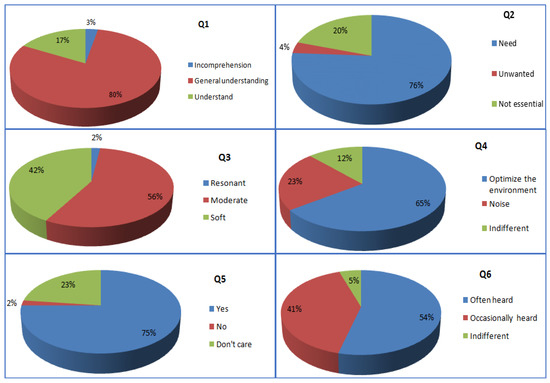
Figure 5.
Percentage of answers to questions 1–6 (Q1–Q6 in Table 1) in Qingyuan Campus of Anhui University and Feicui Lake Scenic Spot (N = 100).

Figure 6.
Percentage of answers to questions 7–10 (Q7–Q10 in Table 1) in Qingyuan Campus of Anhui University and Feicui Lake Scenic Spot (N = 100).
3.2. Effect of Environmental Music on the Growth of Zephyranthes candida (Experiment 2)
The results showed that the stems, leaves, and roots of Zephyranthes candida grew more vigorously under the influence of environmental music, and, especially, the stems and leaves were altered significantly (Figure 7). Thus, it is a possibility that environmental music promoted the growth of Zephyranthes candida commonly found in the urban ecosystem. Studies have shown that audio can stimulate the expansion of stomata in Zephyranthes candida leaves and cause more adsorption of carbon dioxide (the raw material of photosynthesis) by Zephyranthes candida leaves, increase the intensity of photosynthesis, and thus enhance the growth of plants. In this study, the dynamic monitoring was conducted on the chlorophyll content of Zephyranthes candida with environmental music added and without music played (measured from the 10th day after germination and once every 5 days). Under the influence of environmental music, the chlorophyll content of Zephyranthes candida was significantly higher than that without playing environmental music over time (Table 2).
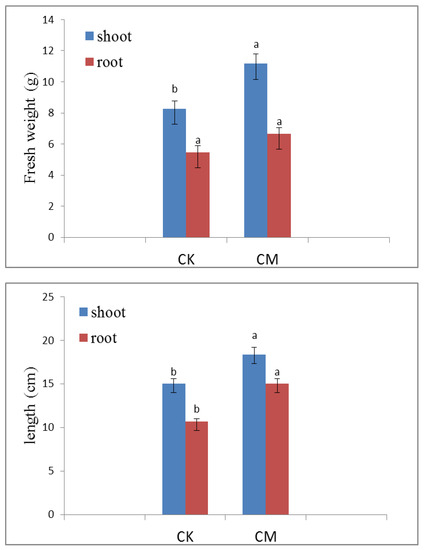
Figure 7.
Growth of scallion after 30 days of different treatments (CK: no sound; CM: used audio player to play 80 dB(A) classical music. Different letters represent the difference of the same indicator under different treatment conditions; p < 0.05).

Table 2.
Chlorophyll content in leaves of scallion during 10–30 days of growth after germination (mg/g).
3.3. Relationship between Environmental Music and Urban Ecological Planning
The environmental music playback types of Feicui Lake Park Scenic Spot are shown in Figure 8, indicating that in order to promote plant growth and the comfort of the park population, ethnic instrumental music was mainly broadcasted. According to the above test results, we can propose that there are some connections between environmental music and the urban ecosystem. Environmental music is a compound syntagm of “environment” and “music”, which is the influence of music on the environment and the acceptance of the environment for music. The urban ecosystem is the main place where environmental music exists and is applied, and thereby they may be closely linked. Firstly, as a kind of cultural information flow, environmental music plays a role of communication in the urban ecosystem. The distribution and characteristics of environmental music are coupled with the pattern of the urban ecosystem to a certain extent. Secondly, the promotion of environmental music on plant growth and labor productivity indirectly affect the material cycle and energy flow in the urban ecosystem. Moreover, environmental music plays different roles in regulating the main body (residents or consumers) of the urban ecosystem and has different environmental effects.
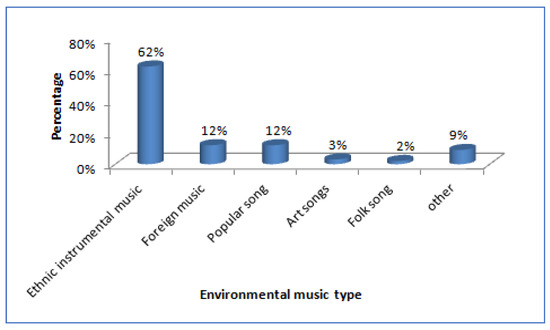
Figure 8.
Percentage of different music types broadcasted in Feicui Lake Scenic Spot.
4. Discussion
4.1. Coupling Mechanism and Design of Urban Ecological Planning and Environmental Music
The results of this study are basically consistent with those of some researchers [6,7,8,9,12,13,26,27,28,29,30,31,32]. For example, researchers have found that the melodic features (pitch histogram) of almost all traditional Chinese (five-tone) folk music conformed to a normal distribution, whose melodic beauty is entirely in line with the Chinese culture of the golden mean [33,34]. That is to say, Chinese folk music is melodically natural in the golden mean. This type of music is beneficial to urban harmony and spiritual civilization as environmental music. Music affects human psychology; this is also basically consistent with the results of our research on the soundscape of underground commercial space in Lu’an City and Hefei City, China, in May 2021 [20]. Environmental music, as a special type of music, has the same functions as music, enriching people’s cognition and promoting the development of imagination and creativity. At the same time, it can also cultivate people’s sentiments and have a certain impact on their thoughts and moral concepts.
Music can also affect the growth of plants; this study showed that vibration generated by music can stimulate the surface of plant leaves, and it can stimulate the expansion of stomata in Zephyranthes candida leaves, cause more adsorption of carbon dioxide by Zephyranthes candida leaves, increase the intensity of photosynthesis, and thus enhance the growth of plants. This is basically consistent with our research results on the effects of sound waves on water spinach (Ipomoea aquatica Forsk.) in March 2020 [22], and also basically consistent with our research results on the effects of sound waves on lettuce (Lactuca sativa L. var. ramosa Hort.) (greenhouse temperature: 24 ± 4 °C, relative humidity: 65 ± 5%) in March and April 2021 [21]. On the other hand, the “stimulation” of music treatments can affect the yield of Zephyranthes candida; Zephyranthes candida may produce the physiological changes in the process of “enjoying” music, leading to the changes in growth capacity.
Through the above research, we can propose that scientific urban ecological planning and design can maintain the urban ecosystem. A virtuous circle presents a pattern of coordinated development of urban construction, economic construction, and environmental construction. The concept of an ecosystem is the core of ecology. According to the definition of A.G. Tansley (1935) [35], ecosystem refers to the unity of biological organisms (animals, plants, and microorganisms) within a certain range and the surrounding inorganic living environment (air, water, and soil). It is a biological and environmental system, which performs the functions of material circulation, energy flow, and information transmission. The urban ecosystem is a human-centered terrestrial ecosystem, which has changed its structure, material circulation, and energy transformation, and has been affected by human activities for a long time. The urban ecosystem is also an artificial ecosystem formed by the interaction between urban residents and their environment [19]. Its main characteristics include being human-centered, having a strong dependence on the outside, and an intensive flow of people, logistics, energy, information, and capital.
In most places of urban ecological systems, it is easy to generate environmental disorders, acoustic environment dislocation, and other negative effects due to the lack of scientific consideration for the materials and the playing forms of environmental music [36,37,38]. This reflects the lag of relevant theory and applied research, which cannot meet the market’s demand for environmental music production and people. In addition, the education and follow-up work of environmental civilization consciousness of sound have not been paid enough attention, thus affecting the benign development of environmental music functions. It can be seen that the rationalization application of environmental music is worthy of being studied further [39,40,41]. Referring to experiments and relevant research data in China and abroad [4,5,9,20,21,22], the authors summarize several suggestions on environmental music as follows:
First, the melody creation and orchestration should not be too prominent; in other words, environmental music should not be made too attractive. Otherwise, it will divert the attention of the main people in the city and achieve the opposite effects. Second, for comfort and functionality, the selection of environmental music should take the comfort level of people as the main reference. Different occasions, theme activities, and the choice of environmental music are different. Third, for environmental integration, the choice of environmental music should follow the integration of the environment, that is, it should be integrated with the architectural style and management characteristics in urban planning, as well as the needs of residents. The overall goal of environmental music design is to achieve the harmony between environment and humans, and promote the development of the urban economy and ecology. Fourth, the production of environmental music should be specially designed and personalized. The production of environmental music can be made for a certain enterprise or a specific occasion, rather than a few ready-made pieces of music, and should provide a certain theoretical basis for development on the basis of repeated trials.
4.2. Difficulties and Limitations of Coupling Urban Ecological Planning and Environmental Music
Currently, there are few reports on the relationship between environmental music and ecosystem. Researchers have carried out some relevant exploration and analysis. For example, the analysis of the transformation coordination between environmental music and noise pollution showed that environmental music might become the source of noise and produce negative environmental effects because of its failure to fully utilize, or even abuse [42,43,44,45,46,47]. Environmental music may give people new productivity and quality of life, which reflects the people-oriented characteristics of the urban ecosystem [48,49,50,51,52,53]. However, few reports or papers have systematically studied the functional mechanism and the effects of environmental music on the urban ecosystem. The difficulties are reflected in the following aspects, and these are actually the limitations of the current study as well:
First, the mobility of populations brings difficulties for the survey accuracy in different functional groups of the urban ecosystem. Therefore, it is necessary to select long-living or long-active individuals for the interview survey in a certain functional area [53,54,55]. Second, the decibel measurement of environmental music is unstable and measurement points are difficult to select, thereby it is necessary to measure and distribute the points reasonably several times in order to ensure the accuracy of data [56,57,58]. Third, the selection of typical functional areas and the identification of environmental music are very important, which requires a lot of investigation data and experience. Fourth, to verify the function of environmental music in small experiments, it is essential to design and use urban environmental music with good communication in appropriate places.
According to the fundamental purpose and main characteristics of urban ecological planning, the Chinese Ministry of Environmental Protection has proposed relevant requirements for the planning and quality standards of acoustic environment functional zones, namely, the environmental quality standards for noise (GB 3096-2008), which clearly stipulates the corresponding regional types and environments of different acoustic environments functional zones and is also part of China’s efforts in urban ecological planning. The core content of ecological construction is to make full use of modern science and technology and the natural laws of the ecological system, combine nature and artificiality, achieve efficient harmony, and finally realize the win–win of economic development and environmental protection. In order to promote the productivity development and social harmony and protect the ecological environment, musicology researchers should connect urban planning science with environmental science.
5. Conclusions
Environmental music has a typical role in different ecological functional areas in the city. Different types of environmental music can affect people’s psychological states and the growth of plants to a certain extent, and has different ecological and environmental effects. Therefore, acoustic environment is an important factor in urban ecological planning. Urban ecological planning needs to give people the opportunity to choose the acoustic environment. It is unwise to impose general auditory aesthetics on people in the same way as ordinary visual aesthetics, because sound perception is more subjective than visual objects. Environmental music will become an interesting and new direction of urban research. By creatively integrating landscape architecture, ecology, musicology, acoustics, psychology, and innovative design, the environmental music design will have a decisive impact on building a sustainable and comfortable city in the future. Environmental music could give people new production efficiency and life quality in modern life, which reflects the people-oriented characteristics of urban ecological planning. In the future, we will continue to explore more functions of environmental music in urban sustainable development. We believe the combination of environmental music and urban ecological planning will be the driving force for the sustainable development of modern cities, thus promoting the development of the urban economy, which will be the eternal driving force for scientific researchers.
Author Contributions
S.W. preformed investigation. H.H. and Q.X. performed conceptualization. S.W. performed writing. Q.X. performed formal analysis and project administration. All authors have read and agreed to the published version of the manuscript.
Funding
This work was supported by the Borrowing Transfer to Supplement Foundation of Hefei (J2019D04), the double base demonstration teaching organization “Department of Food Engineering” of Anhui Provincial Department of Education (2020SJSFJXZZ332), the Anhui Quality Engineering Project Practice Education Base (2021xqhzsjjd069), Hefei University Quality Engineering Project Course Ideological and Political Demonstration (2021hfukcsz09), Provincial “double base” course of Anhui Province “Basic music theory ” (2020SJJXSFK0072), Provincial “double base” course of Anhui Province “saxophone” (2020SJJXSFK0071), Anhui Province Philosophy and Social Science Planning project: “Study on the evaluation and Optimization Strategy of Music Sound Environment in Anhui Urban Public Space” (AHSKQ2019D081), and the National Natural Science Foundation of China (41501355).
Institutional Review Board Statement
Not applicable.
Informed Consent Statement
Not applicable.
Data Availability Statement
Not applicable.
Conflicts of Interest
The authors declare no conflict of interest.
References
- Addanki, S.C.; Venkataraman, H. Greening the economy: A review of urban sustainability measures for developing new cities. Sustain. Cities Soc. 2017, 32, 1–8. [Google Scholar] [CrossRef]
- Ahern, J. Urban landscape sustainability and resilience: The promise and challenges of integrating ecology with urban planning and design. Landsc. Ecol. 2013, 28, 1203–1212. [Google Scholar] [CrossRef]
- Grafius, D.R.; Corstanje, R.; Warren, P.H.; Evans, K.L.; Hancock, S.; Harris, J.A. The impact of land use/land cover scale on modelling urban ecosystem services. Landsc. Ecol. 2016, 31, 1509–1522. [Google Scholar] [CrossRef]
- Reybrouck, M. Music as Environment: An Ecological and Biosemiotic Approach. Behav. Sci. 2015, 5, 1–26. [Google Scholar] [CrossRef] [PubMed]
- Roschk, H.; Loureiro, S.M.C.; Breitsohl, J. Calibrating 30 Years of Experimental Research: A Meta-Analysis of the Atmospheric Effects of Music, Scent, and Color. J. Retail. 2017, 2, 228–240. [Google Scholar] [CrossRef]
- Cowen, A.S.; Fang, X.; Sauter, D.; Keltner, D. What music makes us feel: At least 13 dimensions organize subjective experiences associated with music across different cultures. Proc. Natl. Acad. Sci. USA 2020, 117, 1924–1934. [Google Scholar] [CrossRef] [PubMed]
- Jaušovec, N.; Jaušovec, K.; Gerlic, I. The influence of Mozart’s music on brain activity in the process of learning. Clin. Neurophysiol. 2006, 117, 2703–2714. [Google Scholar] [CrossRef]
- Jaušovec, N.; Habe, K. The influence of auditory background stimulation (Mozart’s sonata K. 448) on visual brain activity. Int. J. Psychophysiol. 2003, 51, 261–271. [Google Scholar] [CrossRef]
- Notaro, S.; De Salvo, M. Does Music Affect Visitors’ Choices for the Management and Conservation of Ecosystem Services? Sustainability 2021, 13, 10418. [Google Scholar] [CrossRef]
- Chalmers, L.; Olson, M.R.; Zurkowski, J.K. Music as a Classroom Tool. Interv. Sch. Clin. 1999, 35, 43–52. [Google Scholar] [CrossRef]
- North, A.C.; Sheridan, L.P.; Areni, C.S. Music Congruity Effects on Product Memory, Perception, and Choice. J. Retail. 2016, 92, 83–95. [Google Scholar] [CrossRef]
- Choo, B.J.-K.; Cheok, T.-S.; Gunasegaran, D.; Wan, K.-S.; Quek, Y.-S.; Tan, C.S.-L.; Quek, B.-K.; Gan, S.K.-E. The sound of music onthe pocket: A study of background music in retail. Psychol. Music 2020, 49, 1381–1400. [Google Scholar] [CrossRef]
- Herget, A.-K.; Breves, P.; Schramm, H. The Influence of Different Levels of Musical Fit on the Efficiency of Audio-Visual Advertising. Music. Sci. 2020, 26, 102986492090409. [Google Scholar] [CrossRef]
- Kantono, K.; Hamid, N.; Shepherd, D.; Lin, Y.H.T.; Skiredj, S.; Carr, B.T. Emotional and electrophysiological measures correlate to flavour perception in the presence of music. Physiol. Behav. 2019, 199, 154–164. [Google Scholar] [CrossRef]
- Biswas, D.; Lund, K.; Szocs, C. Sounds like a healthy retail atmospheric strategy: Effects of ambient music and background noise on food sales. J. Acad. Mark. Sci. 2019, 47, 37–55. [Google Scholar] [CrossRef]
- Kato, T.; Rice, T.S.; Spencer, S.M.; Thomas-Rogers, D.J.; Kerns, K.M. Neurophysiological Investigation on Differential Effects of Computer-Generated-Modal Music—Implication for Music Therapy. Ann. Behav. Med. 2017, 51 (Suppl. S1), S1953–S1954. [Google Scholar]
- Kato, T.; Rice, T.S.; Hammond, A.D.; Lamp, K.M.; Fogg, E.N. Music with 1/F Fluctuation Causes Greater Happiness and Relaxation—Brain Physiological Investigation. Ann. Behav. Med. 2014, 47, S213. [Google Scholar]
- Soh, K.L.; Jayaraman, K.; Choo, L.P.; Kiumarsi, S. The impact of background music on the duration of consumer stay at stores: An empirical study in Malaysia. Int. J. Bus. Soc. 2015, 16, 247–260. [Google Scholar] [CrossRef]
- Burtner, M. Climate Change Music: From Environmental Aesthetics to Ecoacoustics. S. Atl. Q. 2017, 1, 145–161. [Google Scholar] [CrossRef]
- Wang, S.; He, H.; Li, F.; Xiao, Q. A Study on the Soundscape of Underground Commercial Space in Lu’an City and Hefei City, China. Int. J. Environ. Res. Public Health 2023, 20, 1971. [Google Scholar] [CrossRef]
- Wang, S.; Xiao, Q. Effect of Audio Control Technology on Lettuce Growth. Sustainability 2023, 15, 2776. [Google Scholar] [CrossRef]
- Wang, S.; Shao, Y.; Duan, J.; He, H.; Xiao, Q. Effects of Sound Wave and Water Management on Growth and Cd Accumulation by Water Spinach (Ipomoea aquatica Forsk.). Agronomy 2022, 12, 2257. [Google Scholar] [CrossRef]
- Aerial Photo of Qingyuan Campus. Available online: https://www.ahu.edu.cn/2010/0702/c154a162/page.htm (accessed on 15 February 2023).
- Aerial Photography: Autumn is Over and Summer Is Not Over (Reprinted on Xinhuanet). Available online: https://m.sohu.com/a/336957462_115423?_trans_=010004_pcwzy (accessed on 15 February 2023).
- Zephyranthes Candida (Lindl.) Herb. Available online: https://baike.baidu.com/item/%E8%91%B1%E8%8E%B2/1703249?fromtitle=Zephyranthes%20candida&fromid=15869841&fr=aladdin (accessed on 15 February 2023).
- Zentner, M.; Grandjean, D.; Scherer, K.R. Emotions Evoked by the Sound of Music: Characterization, Classification, and Measurement. Emotion 2008, 8, 494–521. [Google Scholar] [CrossRef] [PubMed]
- Hunter, P.G.; Schellenberg, E.G.; Schimmack, U. Feelings and perceptions of happiness and sadness induced by music: Similarities, differences, and mixed emotions. Psychol. Aesthet. Creat. 2010, 4, 47–56. [Google Scholar] [CrossRef]
- Sarvaiya, N.; Kothari, V. Effect of audible sound in form of music on microbial growth and production of certain important metabolites. Microbiology 2015, 84, 227–235. [Google Scholar] [CrossRef]
- Munasinghe, D.S.P.; Weerakoon, S.R.; Somaratne, S. The effect of Buddhist pirith chanting and Western pop music on growth performance of “Pranajeewa”, Codariocalyx motorius (Houtt.) H. Ohashi. Ceylon J. Sci. 2018, 47, 357–361. [Google Scholar] [CrossRef]
- Munasinghe, D.S.P.; Liyanage, K.C.M.; Weerakoon, S.R.; Somaratne, S.; Dissanayake, D.M.L.C. A preliminary study on effect of Buddhist pirith chanting and pop music on the growth and yield performance in rice (Oryza sativa L.). Sri Lankan J. Biol. 2018, 3, 44–51. [Google Scholar] [CrossRef]
- Creath, K.; Schwartz, G.E. Measuring effects of music, noise, and healing energy using a seed germination bioassay. J. Altern. Complement. Med. 2004, 10, 113–122. [Google Scholar] [CrossRef]
- Singh, P.; Srivastava, N.; Joshi, N.; Shastri, I. Impact of different musical nodes and vibrations on plant development. Plant Sci. Today 2019, 6, 639–644. [Google Scholar] [CrossRef]
- Liu, H.; Xue, T.; Schultz, T. Merged Pitch Histograms and Pitch-duration Histograms. In Proceedings of the 19th International Conference on Signal Processing and Multimedia Applications—SIGMAP, Lisbon, Portugal, 14–16 July 2022; SciTePress: Setubal, Portugal, 2022; pp. 32–39. [Google Scholar] [CrossRef]
- Liu, H.; Jiang, K.; Gamboa, H.; Xue, T.; Schultz, T. Bell Shape Embodying Zhongyong: The Pitch Histogram of Traditional Chinese Anhemitonic Pentatonic Folk Songs. Appl. Sci. 2022, 12, 8343. [Google Scholar] [CrossRef]
- Tansley, A.G. The Use and Abuse of Vegetational Concepts and Terms. Ecology 1935, 16, 284–307. [Google Scholar] [CrossRef]
- Eldridge, A.; Casey, M.; Moscoso, P.; Peck, M. A new method for ecoacoustics? Toward the extraction and evaluation of ecologically-meaningful soundscape components using sparse coding methods. PeerJ 2016, 4, e2108. [Google Scholar] [CrossRef] [PubMed]
- Bormpoudakis, D.; Sueur, J.; Pantis, J.D. Spatial heterogeneity of ambient sound at the habitat type level: Ecological implications and applications. Landsc. Ecol. 2013, 28, 495–506. [Google Scholar] [CrossRef]
- Pieretti, N.; Duarte, M.; Sousa-Lima, R.; Rodrigues, M.; Young, R.; Farina, A. Determining temporal sampling schemes for passive acoustic studies in different tropical ecosystems. Trop. Conserv. Sci. 2015, 8, 215–234. [Google Scholar] [CrossRef]
- Gasc, A.; Sueur, J.; Jiguet, F.; Devictor, V.; Grandcolas, P.; Burrow, C.; Depraetere, M.; Pavoine, S. Assessing biodiversity with sound: Do acoustic diversity indices reflect phylogenetic and functional diversities of bird communities? Ecol. Indic. 2013, 25, 279–287. [Google Scholar] [CrossRef]
- Ng, M.-L.; Butler, N.; Woods, N. Soundscapes as a surrogate measure of vegetation condition for biodiversity values: A pilot study. Ecol. Indic. 2018, 93, 1070–1080. [Google Scholar] [CrossRef]
- Tucker, D.; Gage, S.H.; Williamson, I.; Fuller, S. Linking ecological condition and the soundscape in fragmented Australian forests. Landsc. Ecol. 2014, 29, 745–758. [Google Scholar] [CrossRef]
- Aletta, F.; Kang, J. Soundscape approach integrating noise mapping techniques: A case study in Brighton. Noise Mapp. 2015, 2, 1–12. [Google Scholar] [CrossRef]
- Herranz-Pascual, K.; Iraurgi, I.; Aspuru, I.; Garcia-Pérez, I.; Santander, A.; Eguiguren, J.L. Integrating Soundscape Criteria in Urban Sustainable Regeneration Processes: An Example of Comfort and Health Improvement. Sustainability 2022, 14, 3143. [Google Scholar] [CrossRef]
- Aletta, F.; Oberman, T.; Kang, J. Associations between positive health-related effects and soundscapes perceptual constructs: A systematic review. Int. J. Environ. Res. Public Health 2018, 15, 2392. [Google Scholar] [CrossRef]
- Payne, S.R.; Guastavino, C. Exploring the Validity of the Perceived Restorativeness Soundscape Scale: A Psycholinguistic Approach. Front. Psychol. 2018, 9, 2224. [Google Scholar] [CrossRef]
- Cerwén, G. Urban soundscapes: A quasi-experiment in landscape architecture. Landsc. Res. 2016, 41, 481–494. [Google Scholar] [CrossRef]
- Ojala, A.; Korpela, K.; Tyrväinen, L.; Tiittanen, P.; Lanki, T. Restorative effects of urban green environments and the role of urban nature orientedness and noise sensitivity: A field experiment. Health Place 2019, 55, 59–70. [Google Scholar] [CrossRef] [PubMed]
- Radicchi, A.; Grant, M. From noise to soundscape in the service of urban health. Cities Health 2021, 5, 15–19. [Google Scholar] [CrossRef]
- Heymans, A.; Breadsell, J.; Morrison, G.M.; Byrne, J.J.; Eon, C. Ecological Urban Planning and Design: A Systematic Literature Review. Sustainability 2019, 11, 3723. [Google Scholar] [CrossRef]
- Schulte-Fortkamp, B.; Fiebig, A. Going beyond Noise in Urban Planning—Human Perception Will Be the Trusted Guide. J. Acoust. Soc. Am. 2017, 142, 2672. [Google Scholar] [CrossRef]
- Vogiatzis, K.; Remy, N. From Environmental Noise Abatement to Soundscape Creation through Strategic Noise Mapping in Medium Urban Agglomerations in South Europe. Sci. Total Environ. 2014, 482–483, 420–431. [Google Scholar] [CrossRef]
- Amarilla, R.S.D.; Scoczynski Ribeiro, R.; Henrique de Avelar Gomes, M.; Pereira Sousa, R.; Henrique Sant’Ana, L.; Eduardo Catai, R. Acoustic Barrier Simulation of Construction and Demolition Waste: A Sustainable Approach to the Control of Environmental Noise. Appl. Acoust. 2021, 182, 108201. [Google Scholar] [CrossRef]
- Zappatore, M.; Longo, A.; Bochicchio, M.A. Crowd-sensing our Smart Cities: A Platform for Noise Monitoring and Acoustic Urban Planning. J. Commun. Softw. Syst. 2017, 13, 53–67. [Google Scholar] [CrossRef]
- Asdrubali, F.; D’Alessandro, F. Innovative Approaches for Noise Management in Smart Cities: A Review. Curr. Pollut. Rep. 2018, 4, 143–153. [Google Scholar] [CrossRef]
- Radicchi, A.; Henckel, D.; Memmel, M. Citizens as smart, active sensors for the quiet and just city. The case of the “open source soundscapes” approach to identify, assess and plan “everyday quiet areas” in cities. Noise Mapp. 2018, 5, 1–20. [Google Scholar] [CrossRef]
- Aletta, F.; Oberman, T.; Mitchell, A.; Tong, H.; Kang, J. Assessing the changing urban sound environment during the COVID-19 lockdown period using short-term acoustic measurements. Noise Mapp. 2020, 7, 123–134. [Google Scholar] [CrossRef]
- Margaritis, E.; Kang, J. Soundscape mapping in environmental noise management and urban planning: Case studies in two UK cities. Noise Mapp. 2017, 4, 87–103. [Google Scholar] [CrossRef]
- Can, A.; Gauvreau, B. Describing and classifying urban sound environments with a relevant set of physical indicators. J. Acoust. Soc. Am. 2015, 137, 208–218. [Google Scholar] [CrossRef] [PubMed]
Disclaimer/Publisher’s Note: The statements, opinions and data contained in all publications are solely those of the individual author(s) and contributor(s) and not of MDPI and/or the editor(s). MDPI and/or the editor(s) disclaim responsibility for any injury to people or property resulting from any ideas, methods, instructions or products referred to in the content. |
© 2023 by the authors. Licensee MDPI, Basel, Switzerland. This article is an open access article distributed under the terms and conditions of the Creative Commons Attribution (CC BY) license (https://creativecommons.org/licenses/by/4.0/).